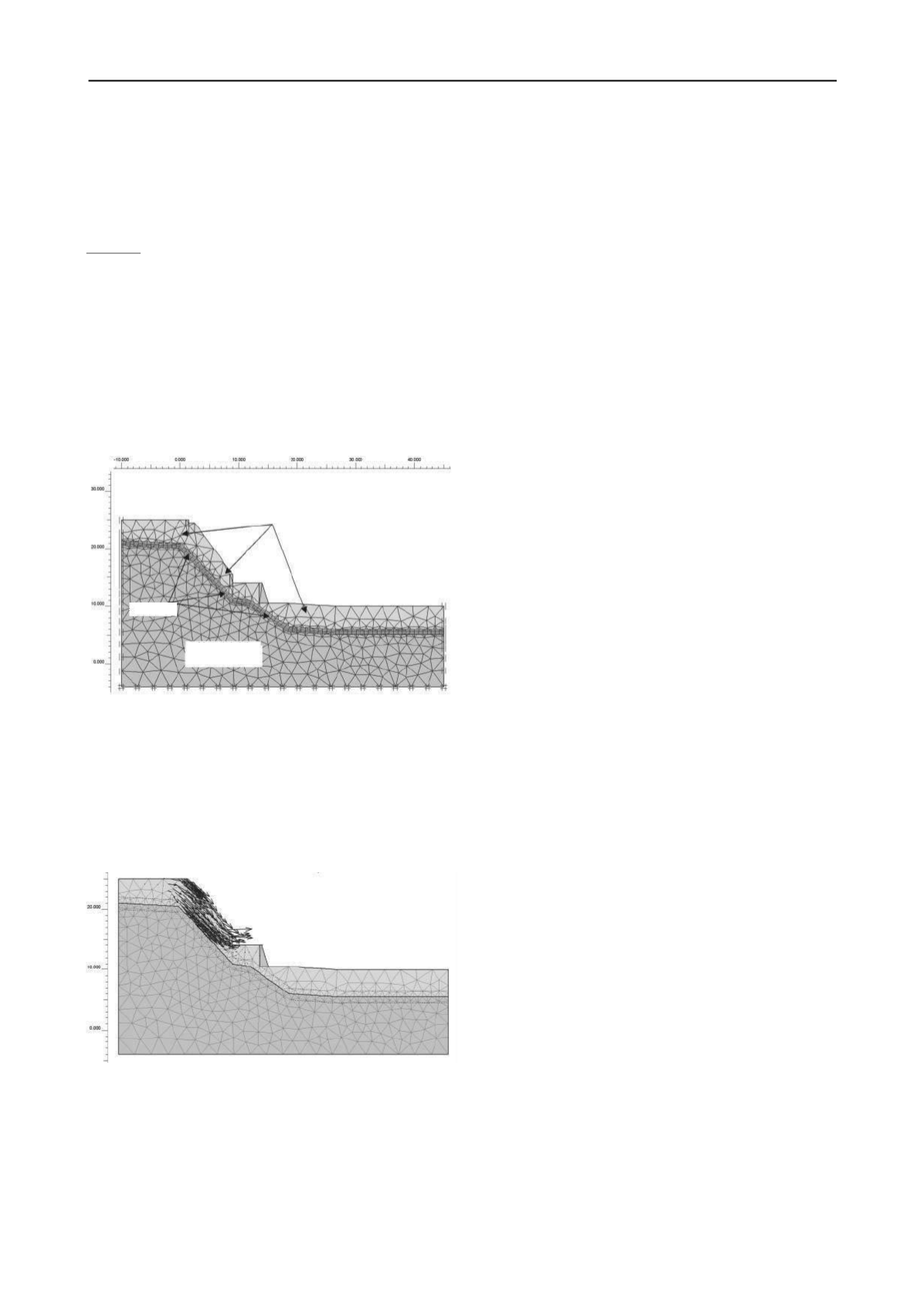
1574
Proceedings of the 18
th
International Conference on Soil Mechanics and Geotechnical Engineering, Paris 2013
Proceedings of the 18
th
International Conference on Soil Mechanics and Geotechnical Engineering, Paris 2013
instability mechanism in more detail, subsoil numerical models
were carried out with the finite elements method, FEM,
considering the geometrical and mechanical conditions
measured. The section of analysis corresponds to the one known
as Axis Section 10, where important cracking has been observed
on the slope’s crown.
Modeling. Fig. 7 shows the mesh of finite elements used in the
analysis that represents in an app
roximate way the slope’s
condition as obtained with a topographical survey. It is a bi-
dimensional mesh with triangular elements of 12 integration
points. Inter-phase elements were placed between the platform
’s
natural material and the fill.
To determine
the slope’s stability, a numerical process was
carried out in which the strata’s mechanical properties are
reduced step by step, from the measured resistance, until
producing a cinematically admissible failure mechanism.
Parametric non linear analyses were made varying the resistance
properties of the inter-phase elements to verify their influence
on the stability. The results obtained are shown below.
Figure 7 Finite elements mesh
Derived from the analyses described above, a probable
failure mechanism was obtained, as shown in Fig. 8. The
slope’s failure is observed not to be rotational, but rather that
there is a sliding or creep of the fill over the natural material of
the Gran Basamento. Such sliding occurs at the point of contact
between both materials, and it generates tension zones at the
slope’s crown, which in turn can produce cracking, such as is
physically observed on the site, as well as a plastification zone
at the point of contact between fill and platform.
Figure 8 Mechanism of probable failure
For current conditions, the safety factor associated to this
failure mechanism is only 1.2. This shows that although the
slope is stable, the condition could easily deteriorate if current
conditions change; for example, when doing a cut, applying a
surface overload and/or when water infiltrates.
6 CONCLUSIONS
The Gran Basamento of Cacaxtla is an earth structure that in the
last few years has presented cracking on the crown of the slopes
and on the top platform, which has affected the main
archeological structures, for example the walls of the Red
Temple and the Venus Temple. If this cracking continues to
develop, slope failures could occur. Therefore, it is necessary to
learn the origin of this cracking. In first instance, the
characteristics of the materials that form the pyramid must be
known, but since it is an archeological monument, it is not
possible to use conventional geotechnical exploration
equipment because important damage would be induced, so
indirect exploration methods have been used, such as the radar
technique, and direct ones, as with the ultra-light penetrometer,
where induced damage is small. Also, a geo-boroscope has been
used, introduced into the drilling made by the penetrometer, in
order to observe directly the characteristics of the materials
penetrated.
The model of the materials that form the pyramid, obtained
through these methods, consists of three basic units: organic
soils, fills and volcanic tuff. Out of these materials surface fills
stand out, consisting of sandy silt and/or silty sand that in some
zones are loose, poorly compacted or of low consistency. Based
on the results of the numerical analyses carried out, it was
concluded that the frontier be
tween these fills and the pyramid’s
natural material (volcanic tuff) is a marked sliding surface that
is activated by the humidification that occurs in some of the
pyramid’s zones or when excavating on the slopes.
Also, with the results from the penetrometer and the geo-
boroscope it was possible to determine different construction
stages of the pyramid, when identifying the various types of fill
and the compacting qualities of those fills. This characteristic
serves as support to carry out archeological studies about the
construction processes applied to the pyramid.
7 REFERENCES
Barba L. 2006.
Estudios de radar en el área del Gran Basamento de
Cacaxtla
, Technical report, UNAM, México.
Diseño e Ingeniería Aplicada 1985.
Estudio de mecánica de suelos de la
zona arqueológica de Cacaxtla
, Technical report, INAH, México.
inGeum 2005.
Estudio del fenómeno de evapotranspiración en la zona
de Coacalco, Edo. De México
. Techncial report, INAH, México.
Instituto Nacional de Antropología e Historia INAH 2001.
Levantamiento fotogramétrico Xichitecatl
, Technical report.
Mexico.
Martínez Romero E. 1985.
Proyecto estructural de la techumbre
metálica
, INAH, México.
Mooser F. 2005. Inspección geológica en Cacaxtla, personal
comunition, México.
National geographic 1992. Map digitized from page 123 (William H.
Bond), September.
Rangel J. L., E. Ovando, L. Barba, D. Molatore, B. Palavicini y J. C.
Araiza, 2006. Análisis geotécnico del Gran Basamento de Cacaxtla,
Coloquio Internacional Cacaxtla a sus treinta años de
investigación
, Tlaxcala, México.
Archeological
fills
Volcanic tuff
Interface


